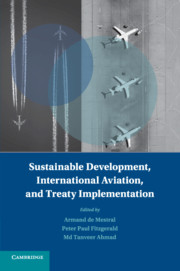Book contents
- Sustainable Development, International Aviation, and Treaty Implementation
- Treaty Implementation for Sustainable Development
- Sustainable Development, International Aviation, and Treaty Implementation
- Copyright page
- Contents
- Figures
- Tables
- Contributors
- Introduction
- Part I Current Status of Global Aviation and Sustainable Development
- Part II Regional Aviation Issues
- 5 Sustainable Development and Emission Trading
- 6 Exporting Environmental Values through Open Skies
- 7 Aviation and Sustainable Development
- 8 Sustainable Aviation and the Transfer of Environmentally Sound Technologies to Africa
- 9 Sustainable Tourism and the Impact of Climate Change on the Caribbean
- Part III Dispute Settlement
- Part IV Future Directions
- Conclusion
- Index
8 - Sustainable Aviation and the Transfer of Environmentally Sound Technologies to Africa
Paradoxes, Barriers, and Prospects
from Part II - Regional Aviation Issues
Published online by Cambridge University Press: 22 August 2018
- Sustainable Development, International Aviation, and Treaty Implementation
- Treaty Implementation for Sustainable Development
- Sustainable Development, International Aviation, and Treaty Implementation
- Copyright page
- Contents
- Figures
- Tables
- Contributors
- Introduction
- Part I Current Status of Global Aviation and Sustainable Development
- Part II Regional Aviation Issues
- 5 Sustainable Development and Emission Trading
- 6 Exporting Environmental Values through Open Skies
- 7 Aviation and Sustainable Development
- 8 Sustainable Aviation and the Transfer of Environmentally Sound Technologies to Africa
- 9 Sustainable Tourism and the Impact of Climate Change on the Caribbean
- Part III Dispute Settlement
- Part IV Future Directions
- Conclusion
- Index
Summary
Sustainable aviation is often propounded as a pathway for promoting efficiency within the aviation sector, while reducing the emission of greenhouse gases from aircraft and other aviation facilities. Attaining sustainable aviation in practice requires large-scale investment in environmentally sound technologies (ESTs) that reduce pollution, use resources in a sustainable manner, utilize renewable sources of energy, and handle all residual waste in a more environmentally acceptable way. Most important are “cleaner” and energy-efficient aircraft, improved facilities for air traffic control and management, and alternative/renewable fuel options.
Current realities, however, show that the availability, affordability, and accessibility of new and cleaner technologies that could promote sustainable aviation remain a huge concern in many African countries. Transferring the requisite ESTs to Africa is often not the most straightforward endeavor. This is mainly due to legal, institutional, and bureaucratic hurdles that make the process challenging and daunting.
This chapter takes a look at the legal and institutional barriers to sustainable aviation in Africa. Drawing examples from Nigeria, South Africa, and Ethiopia, it discusses how legal and governance questions may continue to derail opportunities and efforts to facilitate the transfer of aviation technologies into Africa. Even though some of the legal barriers are preexisting and are not specific to aviation technologies, they must be addressed with respect to aviation, considering the large infrastructural development and technologies required for sustainable aviation projects.
- Type
- Chapter
- Information
- Publisher: Cambridge University PressPrint publication year: 2018



